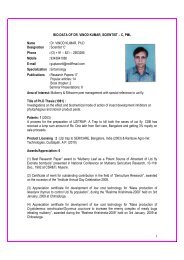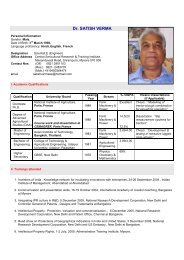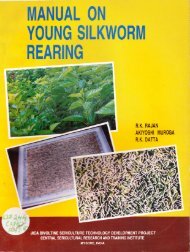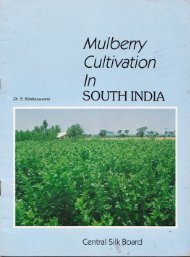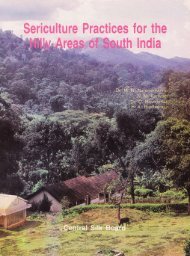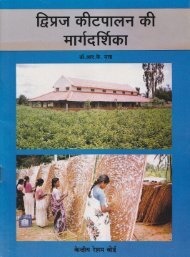BIVOLTINE RACE AND
Manual on Bivoltine Rearing, Race Maintenance and Multiplication
Manual on Bivoltine Rearing, Race Maintenance and Multiplication
- No tags were found...
You also want an ePaper? Increase the reach of your titles
YUMPU automatically turns print PDFs into web optimized ePapers that Google loves.
Thc irrrportant technical aspects for effective chawki management are indicated in Thble 2.<br />
Ttre desired ternperature could be attained by selecting a smaller roorn fitted with heating<br />
arrangefilent and thermostatic control deviee. The fluctuating ternperatures prevailing in<br />
day/night ultirnately tread to poor growth of the fast developing worms. Consequently, humidity<br />
has to be rnaintained by using paraffin paper/poiythene sheet whenever the room humidity is<br />
found below 80% R.H. In the atrsence of electrical device for heating, charcoal heating has to<br />
be done in the night whenever temperature falls below 26"C.<br />
-table 2" Standard chart for young age rearing of 100 Dfls (40,008 larvae)<br />
Factor I Instar II Instar<br />
27 -28<br />
27 -28<br />
85-90<br />
85-90<br />
0.5 - 1.5<br />
1.5 - 4.0<br />
2.5 - 3.0<br />
13.0 - 14.0<br />
1" Temperature ("C)<br />
2. Relative Humidity (%)<br />
3. Leaf size (c*')<br />
4" Quantity of leaf (kg)<br />
5. Bed area (Sq.mtr)<br />
a. In the beginning<br />
b. At the end<br />
c. No. of trays at the<br />
end (120 cm x 90 cm)<br />
6. Bed cieaning<br />
4.7. Moisture content<br />
In newly horn larvae, water content is very low, but increases rapidly upto the second instar<br />
when feeding is given.<br />
0.36<br />
1.35<br />
/1 .+<br />
1.35<br />
4.05<br />
4<br />
twice<br />
-<br />
-<br />
-<br />
-<br />
-<br />
Silhvorms requlre high water content in mulberry leaves to supptry the needed water<br />
incrernent in their bodies.<br />
The moisture content of leaves must be above 78Vo and should have 30Vo protein and<br />
i2% or more carbohydrate.<br />
Variety 536 is found to be gocd in rnoisture retention capacity and suitable for chawki<br />
worms.<br />
Other component of increasing moisture content in leaves is re gular irrigation to the plot<br />
coupled with wider spacing (0.9m x 0.9m) and higher crown height 0.2 - 0.3 m.<br />
For retention of moisture for longer period in treaves shoot harvest (secondary shootlets)<br />
can be practiced as being done in Japan and Brazil (commercial chawki rearers).<br />
4.8. Quality and selection of leaves<br />
More care need to be taken in the selection of leaves of superior quality for theyoungworms.<br />
The suitability of mulberry leaves for young silkworms can be $etermined by the position of the<br />
leaves on the shoot. Harvest one to three leaves below the l#-$est glossy -:"' leaf (near the shoot apex)<br />
'<br />
for the first instar and third to sixth leaves for second instar larvae.<br />
Secondary shootlets (terminal bud and tender portion) are also suitable for young age<br />
rearing.<br />
11




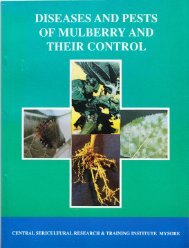

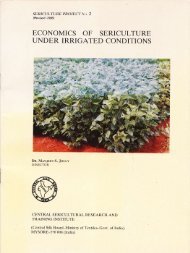
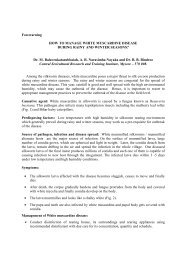
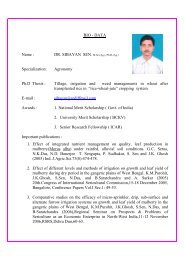
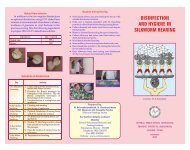
![E}A]\GALORE](https://img.yumpu.com/54052619/1/190x260/eagalore.jpg?quality=85)

